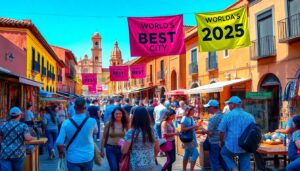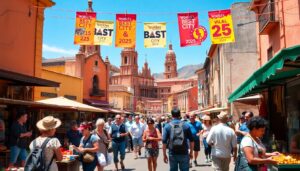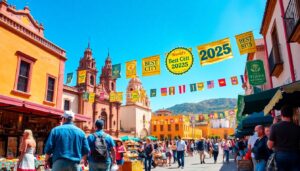Once again, San Miguel de Allende has captured global attention, triumphantly winning the prestigious Travel + Leisure’s World’s Best City 2025 award. This remarkable achievement signifies the fourth time in just eight years that this UNESCO World Heritage colonial gem has dominated the rankings. However, beneath the celebratory headlines lies a complex narrative of transformation, which carries significant implications for both visitors planning their dream trips and residents navigating life in a city often described as the “golden cage” of Mexican tourism success.
Honouring the Recognition: Understanding the Global Impact of San Miguel de Allende
On July 8, 2025, Travel + Leisure revealed its much-anticipated annual World’s Best Awards results, proudly placing San Miguel de Allende at the pinnacle of the “World’s Best Cities” category. This esteemed ranking emerged from comprehensive surveys conducted among over 700,000 readers worldwide, who evaluated various destinations based on criteria such as culture, friendliness, food, shopping, and overall travel experience. This notable accolade marks San Miguel’s fourth triumph since 2017, joining its prior victories in 2017, 2018, and 2024, further solidifying its reputation as a premier travel destination.

This prestigious recognition coincides with numerous other accolades for the city. Notably, Rosewood San Miguel de Allende has been celebrated as the Best Hotel in Mexico for the fifth consecutive year. Additionally, the city continues to proudly hold Condé Nast Traveler’s designation as the No. 1 Small City in the World from previous years, showcasing its enduring appeal.
Understanding the Ranking Methodology Behind Travel + Leisure’s Awards
To fully appreciate the significance of this award, it is essential to explore the methodology that underpins it. The Travel + Leisure World’s Best Awards survey, now in its 30th year, invites enthusiastic travellers to rate various destinations across an array of criteria. The 2025 survey was conducted over a four-month period, effectively promoted through the magazine’s print, digital, newsletter, social media, and website platforms, ensuring a broad reach.
Readers evaluate cities based on diverse factors, including:
- Cultural attractions and activities
- Dining scene and restaurant quality
- Friendliness of locals
- Shopping opportunities
- Overall travel experience and value
San Miguel’s consistent victories reflect its remarkable ability to excel across all of these categories. The city’s unique blend of colonial architecture, a vibrant arts scene, and a robust expat community create an exceptionally welcoming atmosphere for international visitors seeking a rich cultural experience.
Immediate Transformations: The Influences of the Award on San Miguel’s Tourism Landscape
The announcement of this award has already triggered immediate and measurable transformations within the tourism landscape of San Miguel. According to 2025 short-term rental data, the city now boasts over 3,000 active Airbnb listings, with an average occupancy rate of 41% and an average daily rate of $106 USD, reflecting a vibrant rental market.
Substantial Increases in Hotel Rates and Booking Activity
Since the award announcement, hotel occupancy rates have surged dramatically. Premium properties such as Casa de Sierra Nevada and Hotel Matilda are reporting booking increases of up to 35% for the remainder of 2025. Average hotel rates in San Miguel now span from $43 for budget accommodations to over $500 for luxury suites during peak periods, indicating a thriving hospitality sector.
The timing of the award—just before the peak summer travel season—has sparked an immediate frenzy in bookings. Properties that typically had availability through August are now fully booked, with some establishments extending waiting lists into the high season of 2026, highlighting the city’s increasing desirability.
Escalating Demand for Restaurant and Tour Reservations
The acclaimed restaurant scene in San Miguel is currently facing unprecedented demand. Notably, rooftop establishments like Quince and Luna Tapas Bar are reporting booking lead times that have extended from same-day availability to two weeks in advance. Local tour operators offering experiences such as cooking classes and art studio visits have raised their prices by an average of 15-20% since July, reflecting the heightened interest in cultural experiences.
Infrastructure Developments and Municipal Responses to Tourism Growth
The municipal government of San Miguel, under the leadership of Mayor Luis Alberto Villarreal García, has announced several infrastructure enhancements designed to accommodate the increased pressure from tourism. These initiatives include:
- Transportation upgrades: Enhanced shuttle services connecting Guanajuato International Airport (BJX) with downtown San Miguel, making travel more convenient for visitors.
- Parking solutions: New peripheral parking areas with shuttle connections to the historic centre, addressing the need for accessible parking.
- Water and waste management improvements: Upgraded systems to effectively handle seasonal population surges that can triple the city’s base population of 140,000, ensuring sustainability.
- Digital tourism platform: A new app-based system aimed at managing visits to popular sites and reducing overcrowding, enhancing the visitor experience.
UNESCO World Heritage funding continues to play a crucial role in supporting conservation projects, with recent investments directed towards preserving the city’s colonial architecture while accommodating the demands of modern tourism infrastructure.

Local Insights: The Complex Reality of Global Recognition
While municipal officials celebrate the award, the perspectives of residents reveal a more nuanced narrative. In a recent column for Mexico News Daily, local journalist María describes living in San Miguel as “like living in a golden cage”—a beautiful place that is becoming increasingly unaffordable for the native population.
Escalating Housing Crisis Driven by Gentrification
The impact of San Miguel’s global recognition is most visibly reflected in soaring real estate prices. Properties listed at real estate offices now frequently display prices in the millions of dollars, highlighting the growing disparity. Local residents express concerns that houses once owned by their grandparents have now become unattainable for the average Mexican middle-class salary, exacerbating the affordability crisis.
This displacement extends beyond mere economics, affecting cultural traditions as well. The traditional “Friday of Sorrows” celebration, where local homeowners would open their doors to visitors during Holy Week, is diminishing as fewer Mexican families reside in the historic centre, indicating a loss of community and cultural heritage.
Employment Opportunities and the Economic Advantages of Tourism
Despite the challenges posed by gentrification, many locals acknowledge the economic benefits brought by tourism. The rental and service sectors provide employment opportunities for hundreds of San Miguel natives. For instance, many families, including that of the Mexico News Daily columnist, have financed university expenses through long-term rentals to American expatriates, showcasing how tourism can support local livelihoods.
Additions to the city’s cultural fabric, such as new festivals initiated by the international community, including the Guanajuato International Film Festival and San Miguel’s Chamber Music Festival, have created further economic opportunities while enriching the cultural offerings of the city, thus allowing for a more diverse economic base.
Tackling Overtourism: Valuable Lessons from Mexico’s Most Visited Locations
San Miguel’s success story unfolds within a broader context of challenges faced by tourism in Mexico. Recent reports indicate that overtourism in Mexican destinations has seen San Miguel experience a staggering 340% increase in tourism since 2019, attracting over 2.5 million annual visitors.
The city now finds itself alongside popular destinations such as Tulum, Sayulita, and Playa del Carmen, all grappling with serious issues, including:
- Water shortages during peak tourist periods, stressing local resources
- Housing affordability crises that displace local residents
- Strain on waste management systems that struggle to keep up with demand
- Cultural authenticity concerns as local traditions face dilution
Essential Insights for Visitors to San Miguel in 2025-2026
Effective Planning and Booking Techniques for Your Visit
Traveling to San Miguel following the award requires more advance planning than ever before. Visitors should consider the following tips to ensure a smooth experience:
- Book accommodations 4-6 months in advance for high season (November-April) and major festivals to secure the best options.
- Make restaurant reservations immediately upon arrival, especially for highly acclaimed spots like Áperi or 1826, as demand is high.
- Consider shoulder season travel (May-June, September-October) for better availability and rates, allowing for a more enjoyable experience.
- Explore alternative lodging in nearby neighbourhoods such as San Antonio or Los Frailes for more affordable options.

Understanding Price Expectations Following the Award
Budget travellers should be prepared for significant price increases across all categories:
- Accommodation: Budget options now start around $60/night (up from $35 pre-award), reflecting the heightened demand.
- Dining: Upscale restaurants are now averaging $80-120 per person, indicating a rise in dining costs.
- Tours and experiences: Premium offerings like cooking classes range from $150-250, showcasing the city’s cultural richness.
- Transportation: Private transfers from airports have increased by 25-30%, adding to overall travel expenses.
Immerse Yourself in the Vibrancy of Cultural Events: FASMA 2025
The timing of the award coincides beautifully with San Miguel’s Festival of the Arts (FASMA 2025), scheduled for August 1-17. This year’s festival features over 100 events, including performances by 13-time Grammy winner Chuchito Valdés and pianist Gile Bae at the historic Angela Peralta Theatre, promising a rich cultural experience.
Local reports indicate that festival organisers have implemented crowd management strategies to accommodate the anticipated increased attendance. These measures include timed entry systems for popular venues and expanded programming across multiple locations, ensuring a positive experience for all attendees.
Looking Ahead: Embracing Sustainable Tourism Initiatives
The municipal government and tourism board of San Miguel are actively implementing various sustainability measures to responsibly manage growth and mitigate tourism impacts:
- Visitor quotas for popular sites such as the Parroquia de San Miguel Arcángel during peak times, aiming to reduce overcrowding.
- Community tourism programs that ensure local families directly benefit from visitor spending, fostering a sustainable relationship.
- Environmental protections for surrounding natural areas and water resources, highlighting the city’s commitment to ecological preservation.
- Cultural preservation funds supporting traditional festivals and local artisans, ensuring the preservation of local heritage.
Guidelines for Responsible Travel: Expert Recommendations for Visitors
Tourism professionals recommend that visitors can help maintain the appeal of San Miguel by adhering to the following practices:
- Choosing locally-owned accommodations and restaurants over international chains, thereby supporting the local economy.
- Learning basic Spanish phrases to engage respectfully with locals, enhancing cultural exchange.
- Respecting cultural traditions and festival protocols, fostering goodwill within the community.
- Supporting local artisans and markets instead of imported souvenir shops, contributing to the preservation of traditional crafts.
- Participating in community-led cultural experiences, allowing for a deeper understanding of local life.
Addressing Common Concerns: Frequently Asked Questions About San Miguel
Will San Miguel become too crowded to enjoy?
While visitor numbers have significantly increased, San Miguel’s charm remains intact for travellers who plan ahead and visit during shoulder seasons. The city’s expanded cultural programming offers a wealth of experiences, ensuring a fulfilling visit for all.
Are prices now comparable to expensive U.S. cities?
Premium experiences in San Miguel are now approaching U.S. pricing, yet budget and mid-range options continue to be available, particularly outside the immediate historic centre. Dining, local transportation, and numerous cultural activities still provide excellent value for visitors.
How can visitors contribute positively to the local community?
Visitors can choose locally-owned businesses, tip service workers generously, respect cultural events, and engage with the community beyond typical tourist activities. Many travellers find that volunteering with local organisations creates meaningful connections and enhances their overall experience.
Is the award changing San Miguel’s authentic character?
While gentrification pressures are undeniably real, San Miguel maintains its essential character through UNESCO protections, strong local traditions, and an international community that generally respects and contributes to local culture. The key lies in balanced development that benefits both residents and visitors alike, ensuring the preservation of its unique identity.
A City at a Crossroads: Embracing Change While Preserving Heritage
San Miguel de Allende’s fourth title as “World’s Best City” is a testament to both triumph and challenge. This award validates the city’s unique ability to blend colonial charm with contemporary sophistication, but it also amplifies pressures that require careful management and thoughtful responses from all stakeholders.
For travellers, San Miguel remains an extraordinary destination that justifies its global recognition—provided visitors plan accordingly and engage respectfully with the local community. For residents, the ongoing challenge lies in preserving the authentic character that made the city special while benefiting from its international allure and the economic opportunities it brings.
The coming years will be crucial in determining whether San Miguel can maintain its magical balance between global recognition and local authenticity. Early indicators suggest the city is committed to sustainable tourism that honours both its colonial heritage and its vibrant modern community.
Comprehensive Bibliography of Resources
- Travel + Leisure World’s Best Awards 2025
- Travel + Leisure Announces 2025 World’s Best Awards
- Rosewood San Miguel de Allende Named Best Hotel in Mexico
- The Golden Cage: Gentrification in San Miguel – Mexico News Daily
- From San Miguel to Tulum, Mexican Towns Are Being Crushed by Overtourism
- San Miguel de Allende Airbnb Revenue Data 2025
- San Miguel de Allende’s UNESCO World Heritage Status
- Mexico News Daily: San Miguel de Allende July News Roundup
- Hotels in San Miguel de Allende – Momondo
- San Miguel de Allende Tourism Potential Analysis – HVS
The Article: San Miguel de Allende Wins “World’s Best City 2025” Again—What Actually Changes for Locals and Travelers? appeared first on https://fallinginlovewithsanmiguel.com/
The Article World’s Best City 2025: San Miguel de Allende’s Impact on Locals and Travelers Was Found On https://limitsofstrategy.com

